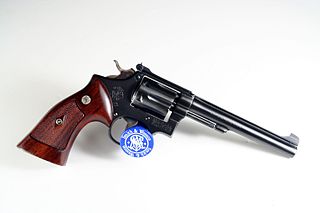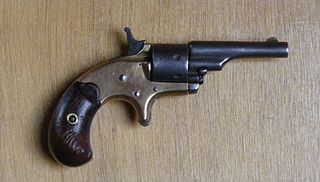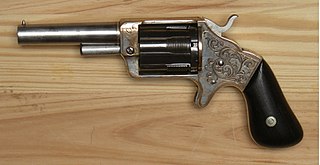History
The American Civil War
For a Civil War soldier, owning a revolver as a backup gun was important, so Smith & Wesson's cartridge revolvers, the Army Model 2 and the Smith & Wesson Model 1 in caliber .22 rimfire came into popular demand with the outbreak of the American Civil War. Soldiers and officers on both sides of the conflict made private purchases of the revolvers for self-defense. Specimens of the model 2 under serial number 35,731 (produced by May 1. 1865) have a high probability of being used in the Civil War. The model 1.5 came into production after the war ended, in 1865.
George Armstrong Custer is known to have owned a pair of cased and engraved S & W Army Model 2 revolvers.
During the Civil War, the State of Kentucky purchased 700 of the S & W Army 2 revolvers from the arms dealer B. Kittredge & Company (based in Cincinnati) and issued them to the 7th Regiment Kentucky Volunteer Cavalry.
Novelist Ernest Hemingway’s paternal grandfather, Anson Hemingway, carried a “Long John” .32 revolver as a first lieutenant in 72nd Illinois Infantry Regiment during the American Civil War. His son—and Hemingway’s father, Clarence—committed suicide with the same weapon in 1928. [3]
Western Frontier
At the close of the Civil War, demand for the S & W Army Model 2 declined and Smith & Wesson focused on the development of arms in heavier calibers suitable for use on the American frontier.
February 1868, in a deal with Remington Arms, Smith & Wesson allowed Remington to convert Remington Model 1858 [4] Percussion Cap revolvers into metallic cartridge .46 rimfire conversions using the Rollin White patent, against payment of a royalty fee.
In 1869 the company developed a large frame break action single action revolver with an automatic empty case ejector, first produced 1870, in the calibers .44 S&W American and .44 Henry. The design is known as the Smith & Wesson Model 3.
The famed American frontiersman and gunslinger Wild Bill Hickok was known to carry a No. 2 later in his life. Following his 1876 murder in Deadwood it was sold along with his personal effects to help pay for burial expenses, in 2022 it was auctioned for $235,000. [5] [6]

The Colt Single Action Army is a single-action revolver handgun. It was designed for the U.S. government service revolver trials of 1872 by Colt's Patent Firearms Manufacturing Company and was adopted as the standard-issued revolver of the U.S. Army from 1873 to 1892.

A rim-fire is a type of metallic cartridge used in firearms where the primer is located within a hollow circumferential rim protruding from the base of its casing. When fired, the gun's firing pin will strike and crush the rim against the edge of the barrel breech, sparking the primer compound within the rim, and in turn ignite the propellant within the case. Invented in 1845 by Louis-Nicolas Flobert, the first rimfire metallic cartridge was the .22 BB Cap cartridge, which consisted of a percussion cap with a bullet attached to the top. While many other different cartridge priming methods have been tried since the early 19th century, such as teat-fire and pinfire, only small caliber rimfire cartridges have survived to the present day with regular use. The .22 Long Rifle rimfire cartridge, introduced in 1887, is by far the most common ammunition found in the world today in terms of units manufactured and sold.

Ethan Allen was a major American arms maker from Massachusetts. He is unrelated to the revolutionary Ethan Allen. His first firearm, the "Pocket rifle" was developed in 1836, and his first patent was granted in 1837.

William Mason was a patternmaker, engineer and inventor who worked for Remington Arms, Colt's Patent Fire Arms Manufacturing Company, and Winchester Repeating Arms Company in the 19th century.

Harrington & Richardson Arms Company is an American brand of firearms and a subsidiary of JJE Capital Holdings. H&R ceased independent production February 27, 2015.

In American English, a pocket pistol is any small, pocket-sized semi-automatic pistol, and is suitable for concealed carry in a pocket or a similar small space.

The Smith & Wesson K-22 Target Masterpiece Revolver is a six-shot, double-action revolver with adjustable open sights, built on the medium-size "K" frame. When introduced, it was intended for bullseye target shooting competition of the type then most common on the United States, which is today called NRA Precision Pistol, specifically in the "smallbore" or "22" category. It is chambered for the .22 Long Rifle cartridge. It is one of three similar models that Smith & Wesson offered, the other two being intended for the "centerfire" category, the K-32 Target Masterpiece chambered for the .32 S&W Long cartridge and the K-38 Target Masterpiece chambered for the .38 Special cartridge. Most K-22 revolvers were fitted with a 6 in (150 mm) or 8+3⁄8 in (210 mm) barrel, but other lengths have been produced. First produced in 1947 and originally known as the K-22 Target Masterpiece, it was numbered the Model 17 in 1957 when all Smith & Wesson guns were given numerical model numbers. It is built on the same frame as the seminal Smith & Wesson Model 10 revolver.
The National Arms Company was a Brooklyn, New York–based manufacturer of firearms that flourished for a decade in the mid-19th century, around the time of the American Civil War.
The Smith & Wesson Model 3 is a single-action, cartridge-firing, top-break revolver produced by Smith & Wesson (S&W) from around 1870 to 1915, and was recently again offered as a reproduction by Smith & Wesson and Uberti.

A snubnosed revolver is a small, medium, or large frame revolver with a short barrel, generally less than 3 inches in length. Smaller such revolvers are often made with "bobbed" or "shrouded" hammers and there are also "hammerless" models ; the point is to allow the gun to be drawn with little risk of it snagging on clothing. Since the external movement of the mechanism is minimal or nil, shrouded and hammerless models may be fired from within clothing. The design of these revolvers compromises range and accuracy at a distance in favor of maneuverability and ease of carry and concealment.

The Remington-Beals Model Revolvers along with subsequent models and variations were percussion revolvers manufactured by Eliphalet Remington & Sons in .31 (Pocket) .36 (Navy) or .44 (Army) caliber, used during the American Civil War, and was the beginning of a successful line of medium and large frame pistols. They are commonly, though inaccurately, referred to as the Model 1858 due to the patent markings on its New Model barrels, "PATENTED SEPT. 14, 1858/E. REMINGTON & SONS, ILION, NEW YORK, U.S.A./NEW MODEL."; although wide scale production did not start until 1861.

A handgun is a firearm designed to be usable with only one hand. It is distinguished from a long barreled gun which typically is intended to be held by both hands and braced against the shoulder. Handguns have shorter effective ranges compared to long guns, and are much harder to shoot accurately. While most early handguns are single-shot pistols, the two most common types of handguns used in modern times are revolvers and semi-automatic pistols.

In firearms, the cylinder is the cylindrical, rotating part of a revolver containing multiple chambers, each of which is capable of holding a single cartridge. The cylinder rotates (revolves) around a central axis in the revolver's action to sequentially align each individual chamber with the barrel bore for repeated firing. Each time the gun is cocked, the cylinder indexes by one chamber. Serving the same function as a rotary magazine, the cylinder stores ammunitions within the revolver and allows it to fire multiple times, before needing to be reloaded.

The Colt Lightning Carbine or Colt Lightning Rifle was a slide-action (pump-action) rifle manufactured by Colt from 1884 until 1904 and was originally chambered in .44-40 caliber. Colt eventually made the Lightning Rifle in three different frame sizes, to accommodate a wide range of cartridges, from .22 Short caliber and .38-40 to .50-95 Express. Its profile resembles the pump-action rimfire rifles made by the Winchester Repeating Arms Company and Remington Arms. The Lightning saw use as a sporting arm in America and was adopted for use by the San Francisco Police Department, but was never as popular or as reliable as the various lever-action rifles of its day. It is however reported to have been used by American forces in the Spanish-American War, most likely as privately purchased weapons.

Merwin, Hulbert, and Co. or Merwin Hulbert was an American firearms designer and marketer based in New York City which produced revolvers and rifles from 1874 to 1896. The firearms were manufactured by a subsidiary company, Hopkins & Allen of Norwich, Connecticut. Merwin Hulbert's designs had influenced other gunmakers of the time, such as Meriden Firearms Co., Harrington & Richardson, Forehand & Wadsworth, and Iver Johnson.

Rollin White was an American gunsmith who invented a single shot bored-through revolver cylinder that allowed paper cartridges to be loaded from the rear of a revolver's cylinder. Because the open breeches were unprotected from lateral fire, all charges would instantly explode in a chain fire. Only one gun would be built to White's specifications, and that for use in a trial to show the impracticality of the gun. The gun could not fire metallic cartridges.

The Colt Model 1871–72 Open Top is a metallic cartridge rear-loading .44-caliber revolver introduced in 1872 by the Colt's Patent Fire Arms Manufacturing Company. This handgun was developed following two patents, the first one in 1871 and the second one in 1872, it is estimated that the production span lies primarily between February 1872 and June 1873. There is therefore still some confusion when naming it. It is sometimes named Colt Model 1871 or Colt Model 1872 but at this time the most common accepted names are Colt Model 1871–72 Open Top, Colt Model 1871–72 or simply Colt Open Top.

The Remington Model 1890 New Model Army was a revolver by Remington Arms. It was based on the successful Remington Model 1875 and the lesser known Model 1888 with both revolvers having the same size, appearance, and the removable cylinder. The 1890 Remington single-actions kept the solid frame and similar styling of the 1875 model, but lacking the large web under the ejector rod housing and equipped with checkered rubber grips. Like the 1875 model, the 1890 was suitably made for metallic cartridges, but only issued in .44-40 caliber.

The Colt Open Top Pocket Model Revolver was a single action pocket revolver introduced by the Colt's Patent Fire Arms Manufacturing Company in 1871. Introduced a year before the Colt Open Top and two years before the Colt Peacemaker and the Colt New Line, the Colt Open Top Pocket Model Revolver was, alongside the Colt House Revolver, one of the two first metallic cartridge rear-loading revolvers manufactured by Colt's. It also was one of the first pocket metallic cartridge revolvers made by the company.

The Slocum Revolver in cal. 32 rimfire was an attempt to circumvent the Rollin White patent. This 5-shot pocket revolver was made 1864 to 1864 by the Brooklyn Arms Co, Brooklyn, New York. Total quantity is estimated to have been more than 10,000 units.






















